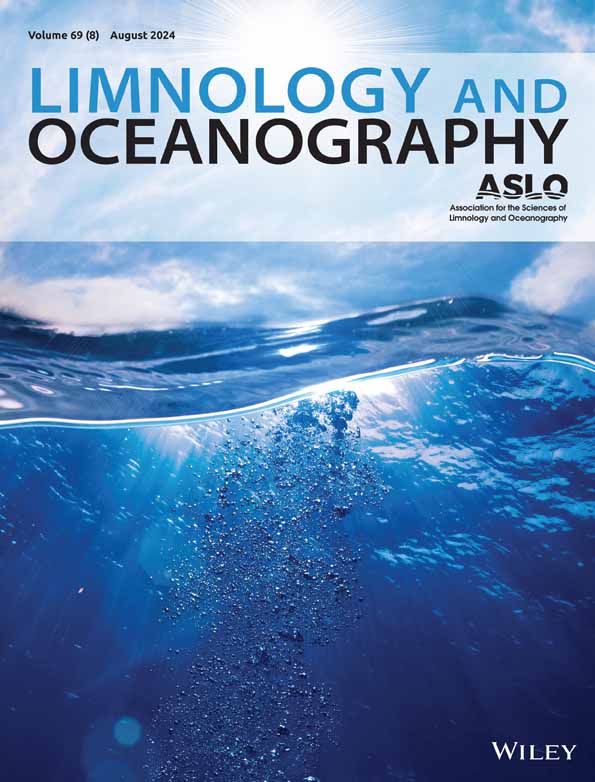用硫同位素追踪海洋羰基硫化物及其前体的来源
IF 3.7
1区 地球科学
Q1 LIMNOLOGY
引用次数: 0
摘要
羰基硫化物(OCS)是平流层硫酸盐气溶胶的主要前体,也是陆地光合作用的代用物。近年来,OCS的硫同位素测量(δ34S)成为限制OCS收支的一种方法。然而,对水生OCS的此类测量仍然很少。本文给出了一个大型的海洋OCS δ34S值数据集。此外,我们还得到了大气中作为对流层OCS重要前体的海洋二硫化碳(CS2)和二甲基硫化物(DMS)的δ34S值。样本采集于大西洋、红海、地中海、瓦登海和北海。气体通过水-空气平衡器取样,保存在罐中,并通过与连接多收集器电感耦合等离子体质谱计的气相色谱仪耦合的预富集系统进行分析。OCS δ34S值为−3.8‰~ 19.4‰,CS2 δ34S值为−10.5‰~ 20‰,DMS δ34S值为14 ~ 23‰。这些δ34S值主要受水柱产油和沉积物产油两个端元控制。实验结果表明,OCS光产物的34S分馏为0.8‰±0.5‰。此外,根据大西洋的测量结果,我们计算出OCS暗产物的34S分馏为- 6‰±2‰。这一新数据大大提高了我们对海洋OCS硫同位素分布的认识,并有助于确定其不同的来源、汇和生产途径。本文章由计算机程序翻译,如有差异,请以英文原文为准。
Sources of marine carbonyl sulfide and its precursors traced by sulfur isotopes
Carbonyl sulfide (OCS) is a major precursor of stratospheric sulfate aerosols and a proxy for terrestrial photosynthesis. In recent years, sulfur‐isotope measurements (δ34 S) of OCS emerged as an approach to constrain the OCS budget. Yet, such measurements are still scarce for aquatic OCS. Here we present a large dataset of δ34 S values of marine OCS. In addition, we present δ34 S values of marine carbon disulfide (CS2 ) and dimethyl sulfide (DMS), which in the air, act as important precursors of tropospheric OCS. Samples were collected at the Atlantic Ocean, the Red Sea, the Mediterranean Sea, the Wadden Sea, and the North Sea. The gases were sampled by a water–air equilibrator, preserved in canisters, and analyzed via a preconcentration system coupled to a gas chromatograph connected to a multi‐collector inductively coupled plasma mass spectrometer. We found δ34 S values of −3.8‰ to 19.4‰ for OCS, −10.5‰ to 20‰ for CS2 , and 14–23‰ for DMS. These δ34 S values are controlled mainly by two endmembers: production in the water column and production in sediments. Lab experiments suggest that the 34 S‐fractionation of OCS photo‐production is 0.8‰ ± 0.5‰. In addition, based on measurements from the Atlantic Ocean, we calculated the 34 S‐fractionation of OCS dark‐production as −6‰ ± 2‰. This new data significantly improves our knowledge of the sulfur isotope distribution of marine OCS and helps identify its different sources, sinks, and production pathways.
求助全文
通过发布文献求助,成功后即可免费获取论文全文。
去求助
来源期刊

Limnology and Oceanography
地学-海洋学
CiteScore
8.80
自引率
6.70%
发文量
254
审稿时长
3 months
期刊介绍:
Limnology and Oceanography (L&O; print ISSN 0024-3590, online ISSN 1939-5590) publishes original articles, including scholarly reviews, about all aspects of limnology and oceanography. The journal''s unifying theme is the understanding of aquatic systems. Submissions are judged on the originality of their data, interpretations, and ideas, and on the degree to which they can be generalized beyond the particular aquatic system examined. Laboratory and modeling studies must demonstrate relevance to field environments; typically this means that they are bolstered by substantial "real-world" data. Few purely theoretical or purely empirical papers are accepted for review.
 求助内容:
求助内容: 应助结果提醒方式:
应助结果提醒方式:


